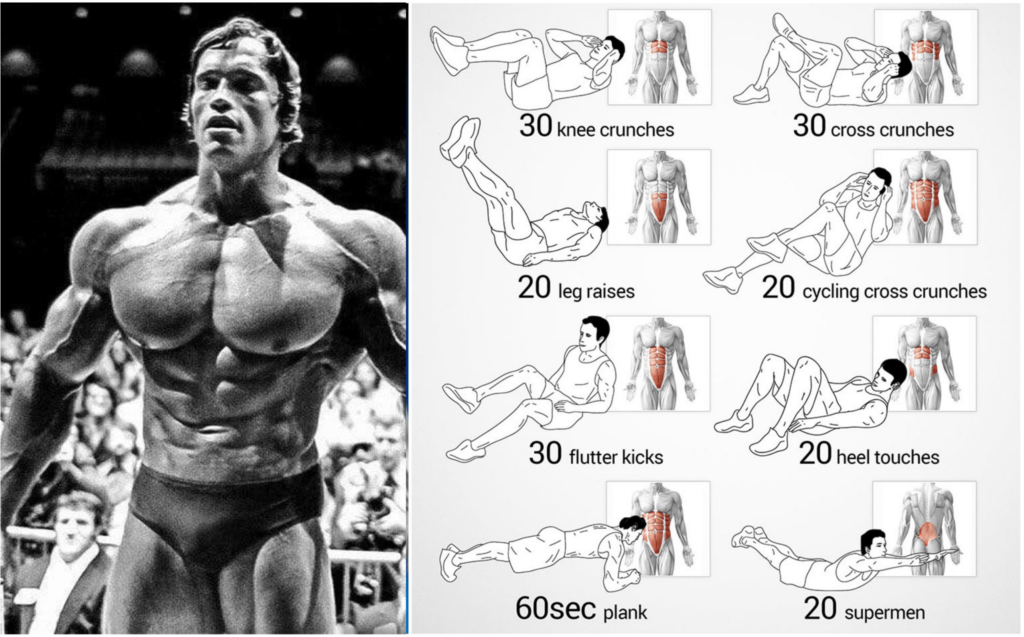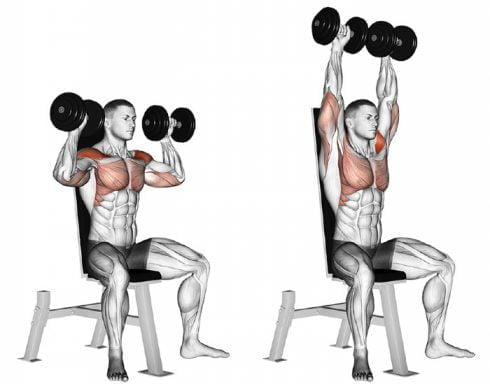Introduction
Having a strong core is crucial for overall fitness, including stability, balance, and posture. A Dumbbell Core Workout can help strengthen your core muscles, which include your abs, back, and hips, leading to improved athletic performance and reduced risk of injury. When you have a strong core, you are better able to maintain proper form and technique during exercises, allowing you to lift heavier weights and increase your overall strength.
Additionally, a strong core can help improve your daily life by reducing the risk of back pain and improving your posture, making it easier to perform everyday activities like lifting and bending. So incorporating a Dumbbell Core Workout into your fitness routine can help you achieve your fitness goals and lead to a healthier lifestyle overall.
Benefits of using dumbbells for core exercises
There are several benefits of using dumbbells for core exercises in a Dumbbell Core Workout.
Firstly, using dumbbells can increase the resistance and intensity of the exercises, leading to greater activation of the core muscles and a more challenging workout. This can lead to greater strength and definition in the core muscles over time.
Secondly, dumbbells can help improve balance and stability during core exercises. By holding onto the weight, you’ll need to engage additional stabilizer muscles in the core to maintain proper form and balance, leading to a more effective workout.
Finally, using dumbbells for core exercises can help to add variety to your workout routine. With a variety of exercises to choose from, you can switch up your routine regularly to keep your muscles guessing and avoid hitting a plateau in your fitness progress.
Warm-up
The warm-up exercises recommended for a Dumbbell Core Workout serve to activate the muscles of the core, while also increasing blood flow and oxygen to the working muscles. Activating the core muscles during the warm-up, it helps to prepare the body for upcoming exercises and reduces the risk of injury by improving the body’s range of motion and flexibility.
The Plank Hold is a great exercise to activate the muscles of the entire core, including the rectus abdominis, obliques, and transverse abdominis. It is also an isometric exercise, which means it involves holding a static position, helping to engage the core muscles and improve their endurance.
The Bird Dog exercise is another great warm-up exercise for the core, as it targets the muscles of the lower back, glutes, and abdominals. This exercise also helps improve stability and balance, which can be beneficial during the Dumbbell Core Workout.
Lastly, the Cat-Cow stretch is an excellent exercise to stretch and warm-up the entire spine, including the muscles of the core. This exercise is particularly useful for those who may be sitting for long periods of time, as it can help alleviate any tightness or stiffness in the back.
Overall, incorporating these warm-up exercises before a Dumbbell Core Workout can help improve performance, reduce the risk of injury, and prepare the body for the upcoming exercises.
Dumbbell Core Exercises

There are several effective dumbbell core exercises that you can include in your Dumbbell Core Workout. Here are a few examples:
Dumbbell Russian Twists
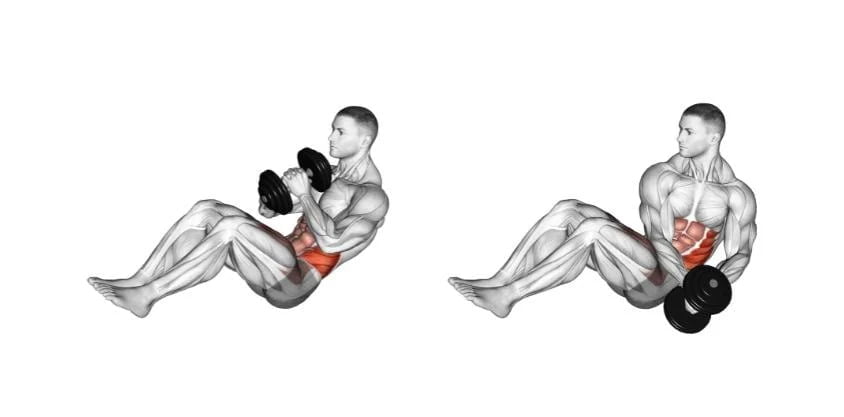
Sit on the floor with your knees bent, feet flat on the ground, and hold a dumbbell with both hands. Lean back slightly, lift your feet off the ground, and twist your torso to the right, bringing the dumbbell to your right hip. Return to the center and twist to the left, bringing the dumbbell to your left hip. This is one rep.
Dumbbell Side Bends

Stand up straight with your feet shoulder-width apart, hold a dumbbell in your right hand, and rest your left hand on your left hip. Bend to the right, keeping your back straight and your left hand on your hip. Return to the center and repeat on the left side. This is one rep.
Dumbbell Wood Chops

Stand with your feet shoulder-width apart, hold a dumbbell in both hands and bring it up over your right shoulder. Keeping your arms straight, pivot on your left foot and chop the dumbbell diagonally across your body to your left hip. Return to starting position and repeat on the other side. This is one rep.
Dumbbell Sit-ups
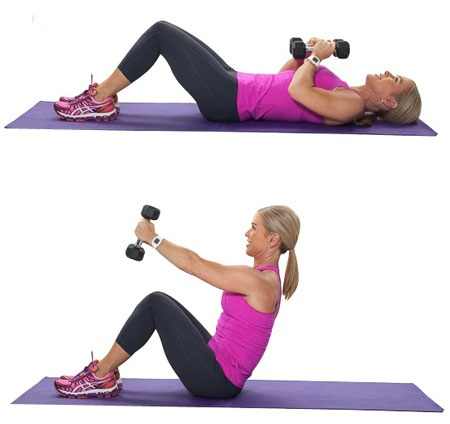
Lie on your back with your knees bent and feet flat on the ground. Hold a dumbbell with both hands and extend your arms above your chest. Use your core muscles to sit up, lifting the dumbbell towards the ceiling. Lower back down to the starting position. This is one rep.
Dumbbell Plank Rows
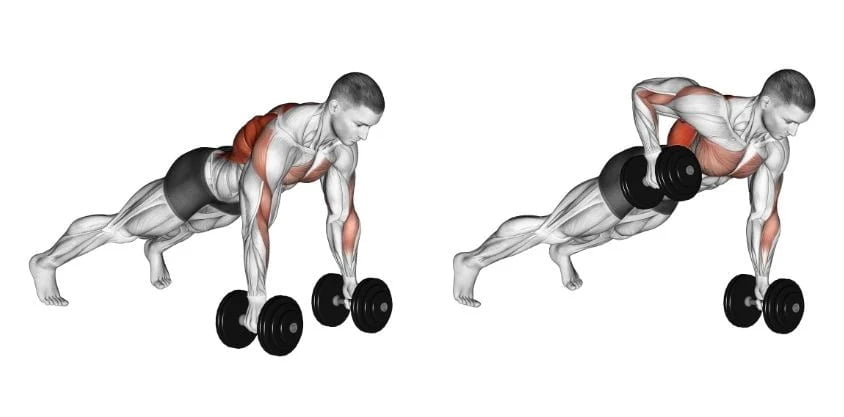
Start in a plank position with a dumbbell in each hand. Engage your core and lift one dumbbell up to your side, keeping your elbow close to your body. Lower the dumbbell back down and repeat on the other side. This is one rep.
Dumbbell Bird Dogs
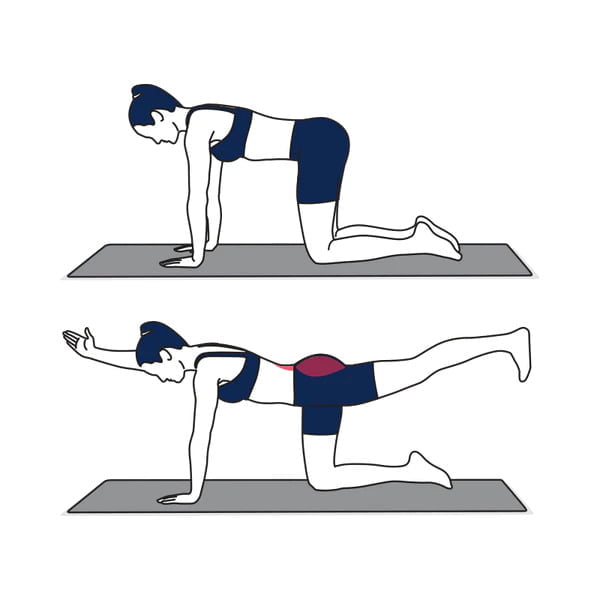
Start on your hands and knees with a dumbbell in your right hand. Extend your left leg behind you and your right arm in front of you, creating a straight line from your hand to your heel. Hold for a moment and then return to the starting position. Repeat on the other side. This is one rep.
Dumbbell Deadlifts
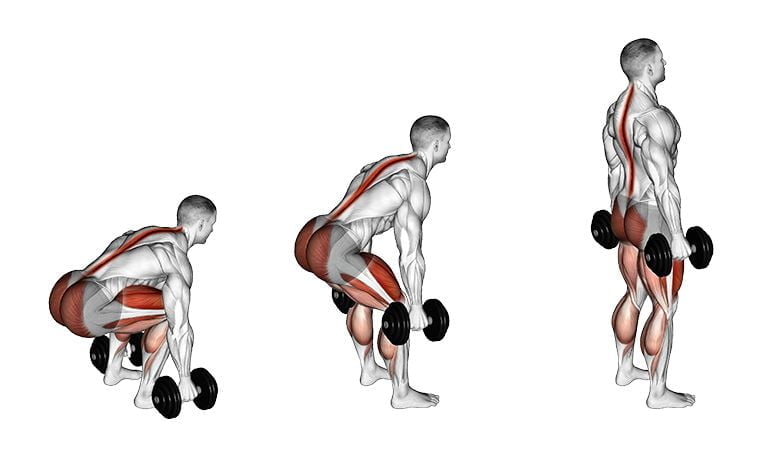
Stand with your feet hip-width apart and hold a dumbbell in each hand with your palms facing your thighs. Keeping your back straight, hinge forward at the hips and lower the dumbbells towards the ground. Pause when you feel a stretch in your hamstrings, then squeeze your glutes to return to the starting position. This is one rep.
Dumbbell Renegade Rows
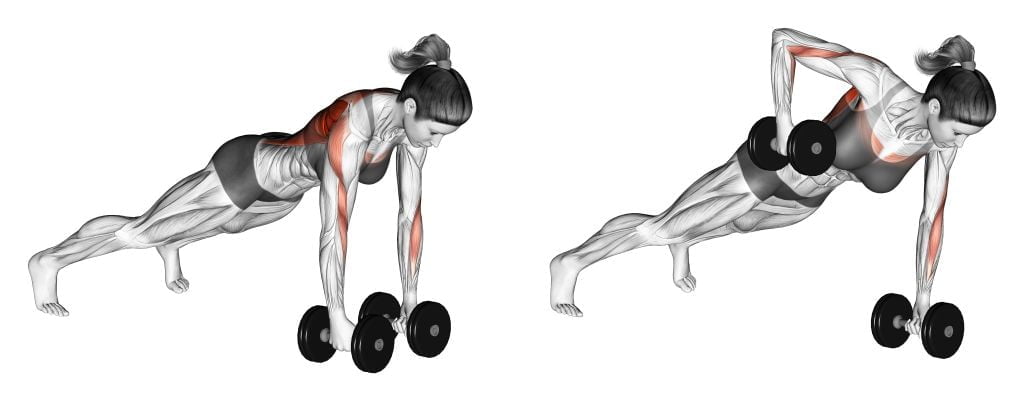
Start in a plank position with a dumbbell in each hand. Engage your core and row one dumbbell up towards your chest, keeping your elbow close to your body. Lower the dumbbell back down and repeat on the other side. This is one rep.
Sample Dumbbell Core Workout
To structure a Dumbbell Core Workout, you want to include a variety of exercises that target all of the major muscle groups in your core. You also want to focus on using proper form and selecting a weight that challenges you, but allows you to maintain good technique throughout the entire workout. Here’s an example Dumbbell Core Workout that you can follow:
Exercise 1: Dumbbell Russian Twists
- Sets: 3
- Reps: 12-15 per side
- Rest: 30 seconds between sets
Exercise 2: Dumbbell Side Bends
- Sets: 3
- Reps: 12-15 per side
- Rest: 30 seconds between sets
Exercise 3: Dumbbell Wood Chops
- Sets: 3
- Reps: 12-15 per side
- Rest: 30 seconds between sets
Exercise 4: Dumbbell Sit-Ups
- Sets: 3
- Reps: 12-15
- Rest: 30 seconds between sets
Exercise 5: Dumbbell Plank Rows
- Sets: 3
- Reps: 10-12 per side
- Rest: 30 seconds between sets
Exercise 6: Dumbbell Bird Dogs
- Sets: 3
- Reps: 10-12 per side
- Rest: 30 seconds between sets
Exercise 7: Dumbbell Renegade Rows
- Sets: 3
- Reps: 10-12 per side
- Rest: 30 seconds between sets
Exercise 8: Dumbbell Deadlifts
- Sets: 3
- Reps: 10-12
- Rest: 30 seconds between sets
For this workout, you would perform each exercise for the specified number of sets and reps, taking a 30-second rest between sets. Once you have completed all six exercises, take a 1-2 minute rest and then repeat the entire circuit two more times. Remember to use proper form and select a weight that challenges you, but allows you to maintain good technique throughout the entire workout.
Cool-down and Stretching
After completing a Dumbbell Core Workout, it’s important to cool down and stretch your muscles to prevent injury and aid in recovery. Cooling down helps to gradually decrease your heart rate and bring your body back to a resting state, while stretching helps to improve flexibility and reduce muscle soreness. Here are some recommended stretches specifically for the core muscles:
- Cat-Cow Stretch: Start on your hands and knees with your wrists under your shoulders and your knees under your hips. Inhale and arch your back, looking up towards the ceiling. Exhale and round your spine, bringing your chin to your chest.
- Cobra Stretch: Lie face down on the floor with your palms on the ground next to your shoulders. Slowly push your upper body up, keeping your hips on the ground. Hold for 15-30 seconds.
- Seated Forward Bend: Sit on the floor with your legs straight out in front of you. Reach forward and grab onto your toes or ankles. Keep your spine straight and hold for 15-30 seconds.
- Spinal Twist: Lie on your back with your arms out to the sides in a T-shape. Bend your right knee and cross it over your left leg, letting it rest on the floor. Gently twist your hips to the right and look over your right shoulder. Hold for 15-30 seconds and then repeat on the other side.
- Child’s Pose: Start on your hands and knees, then sit back on your heels with your arms extended in front of you. Hold for 15-30 seconds.
- Figure Four Stretch: Lie on your back with your knees bent and your feet flat on the floor. Cross your left ankle over your right knee and gently pull your right knee towards your chest. Hold for 15-30 seconds and then repeat on the other side.
- Downward Facing Dog: Start on your hands and knees, then lift your hips up and back, straightening your arms and legs into an upside-down V-shape. Hold for 15-30 seconds.
Incorporating these stretches into your Dumbbell Core Workout routine can help improve your flexibility and prevent muscle soreness. Remember to hold each stretch for at least 15-30 seconds and breathe deeply throughout the stretch.
Tips and Safety Precautions

Here are some tips for maximizing your Dumbbell Core Workout and safety precautions to keep in mind while performing Dumbbell Core Exercises:
Tips:
- Start with lighter weights and gradually increase the weight as you get stronger.
- Focus on proper form and technique to avoid injury and maximize the effectiveness of the exercise.
- Incorporate a variety of exercises to target different areas of the core, including the upper and lower abdominals, obliques, and lower back.
- Breathe deeply and consistently throughout each exercise to engage your core muscles and support your movements.
- Combine Dumbbell Core Exercises with other exercises that target other muscle groups for a complete and balanced workout.
Safety Precautions:
- Always warm up before starting your Dumbbell Core Workout to prevent injury and increase flexibility.
- Use a weight that is appropriate for your strength level and experience. Avoid using weights that are too heavy or difficult to control.
- Keep your back straight and avoid arching it during Dumbbell Core Exercises to avoid back strain.
- Avoid jerky or sudden movements, as this can cause injury.
- If you experience pain or discomfort during any exercise, stop immediately and seek medical attention if necessary.
Form and Technique Tips
When performing a Dumbbell Core Workout, proper form and techniques are crucial for maximizing results and minimizing the risk of injury. Here are some form and technique tips to keep in mind:
- Keep the core engaged: Engage your core muscles throughout each exercise by pulling your belly button towards your spine. This will help to stabilize your torso and protect your lower back.
- Avoid twisting or arching the back: Keep your back straight and avoid any twisting or arching movements. This can put undue stress on your spine and increase the risk of injury.
- Use a controlled, deliberate motion: Use a slow and controlled motion throughout each exercise. This will help to engage the muscles fully and prevent any swinging or momentum from taking over.
- Use a weight that’s appropriate for your fitness level: Choose a weight that allows you to perform each exercise with the proper form and technique. If the weight is too heavy, you may be tempted to use improper form, which can increase the risk of injury.
- Keep your shoulders down: Avoid shrugging your shoulders up towards your ears, as this can cause unnecessary tension in your neck and upper back. Keep your shoulders down and relaxed throughout each exercise.
- Breathe properly: Remember to breathe throughout each exercise. Inhale deeply through your nose before each repetition, and exhale forcefully through your mouth as you contract your core muscles.
- Focus on quality over quantity: It’s important to focus on performing each exercise with the proper form and technique, rather than trying to do as many reps as possible. Quality is more important than quantity when it comes to building a strong and stable core.
- Use a mirror: A mirror can be a helpful tool for ensuring that you’re using proper form and technique during your Dumbbell Core Workout. Position yourself in front of a mirror so that you can check your alignment and make any necessary adjustments.
Remember, the goal of a Dumbbell Core Workout is to build a strong and stable core while minimizing the risk of injury. By following proper form and technique, you can achieve your fitness goals safely and effectively.
Modifications and Progressions
When it comes to modifications for a Dumbbell Core Workout, it’s important to consider your fitness level and any mobility limitations you may have. For beginners or those with limited mobility, starting with lighter dumbbells or bodyweight exercises can be a great way to build strength and improve technique. Some examples of modified exercises for a Dumbbell Core Workout include:
- Instead of using dumbbells, use your bodyweight for exercises such as planks, sit-ups, or bird dogs.
- Using lighter dumbbells or even water bottles or cans as makeshift weights.
- Adjusting the number of reps or sets to suit your fitness level.
- Using modifications such as knee push-ups or supported planks to make exercises easier.
For progressions, the key is to gradually increase the intensity of the workout as your strength and technique improve. Some examples of progressions for a Dumbbell Core Workout include:
- Increasing the weight of the dumbbells used in exercises such as Russian twists or wood chops.
- Adding more reps or sets to the exercises to increase the workload on the muscles.
- Incorporating more challenging exercises such as one-arm dumbbell plank rows, Turkish get-ups, or weighted V-ups.
- Using unstable surfaces such as a stability ball or Bosu ball to add an extra challenge to exercises such as sit-ups or planks.
It’s important to listen to your body and gradually increase the intensity of the workout to avoid injury. Incorporating modifications and progressions into your Dumbbell Core Workout can help keep your routine challenging and effective, no matter your fitness level.
Additional Core Training Tips
When it comes to additional core training tips for a Dumbbell Core Workout, there are a few key things to keep in mind. Firstly, it’s important to include a variety of exercises in your routine in order to work all the muscles of the core. This can include bodyweight exercises such as planks and mountain climbers, which are effective at engaging the entire core, as well as stability ball exercises and yoga poses, which can help build core strength and stability.
Incorporating different exercises can also help prevent boredom and plateaus, as you’ll be challenging your muscles in new ways. It’s important to progressively increase the weight of your dumbbells or the number of reps and sets as your core strength improves, in order to keep making progress and continue challenging your muscles.
In addition to incorporating a variety of exercises and increasing resistance over time, it’s important to always prioritize proper form and technique. This means keeping your core engaged throughout the exercise, avoiding twisting or arching your back, and using a controlled, deliberate motion throughout the exercise. Proper form and technique not only ensure that you get the most out of each exercise, but they also help prevent injury and keep you safe during your workout.
Finally, it’s worth noting that building a strong core is not just about exercise – diet and nutrition also play a key role. Eating a healthy, balanced diet that includes plenty of lean protein, whole grains, and fresh fruits and vegetables can help provide your body with the nutrients it needs to build and repair muscle tissue, while staying hydrated is also important for maintaining optimal performance during your workouts.
Diet and Nutrition
Firstly, a balanced diet that provides enough protein, carbohydrates, and healthy fats is important for supporting muscle growth and recovery. Protein is particularly important for building and repairing muscle tissue, and should be included in every meal and snack throughout the day. Good sources of protein include lean meats, fish, poultry, eggs, beans, lentils, and tofu.
Carbohydrates are also important for providing energy during your workout, as well as helping to replenish glycogen stores in your muscles afterward. Good sources of carbohydrates include fruits, vegetables, whole grains, and legumes.
Healthy fats are another important component of a balanced diet, as they can help to reduce inflammation and support overall health. Good sources of healthy fats include nuts, seeds, avocado, olive oil, and fatty fish like salmon.
When it comes to timing your meals and snacks around your Dumbbell Core Workout, there are a few things to keep in mind. It’s important to have a small snack or meal containing carbohydrates and protein about 30 minutes to an hour before your workout, to provide your body with enough energy to power through your routine. Good options for pre-workout snacks include a banana with almond butter or a protein smoothie with fruits and vegetables.
After your workout, it’s important to refuel your body with a mix of carbohydrates and protein to help repair and rebuild muscles. This can help to reduce muscle soreness and speed up recovery time. Good post-workout options include a turkey and avocado sandwich on whole grain bread, or a grilled chicken and vegetable stir-fry with brown rice.
Overall, by paying attention to your diet and nutrition, you can support your Dumbbell Core Workout and help to achieve your fitness goals.
Conclusion
In conclusion, incorporating a Dumbbell Core Workout into your fitness routine can help strengthen and stabilize your core muscles, leading to improved posture, reduced risk of injury, and enhanced athletic performance. By using dumbbells in core exercises, you can increase resistance and challenge your muscles in new ways, leading to greater strength gains.
However, it’s important to remember that a well-rounded fitness routine also includes a healthy diet and proper nutrition. By fueling your body with the right foods and staying hydrated, you can optimize your workouts and achieve your fitness goals. So, make sure to stay consistent with your Dumbbell Core Workout and prioritize your diet and nutrition for optimal results.

Good day, and welcome to Fitthour. My name is Shubham Vijay, and I am a certified personal trainer and nutrition coach with 6 years of experience in the fitness industry. At Fitthour, we specialize in types of training, such as strength training, cardio, or HIIT, and our mission is to help clients achieve their fitness goals and improve their overall health.

